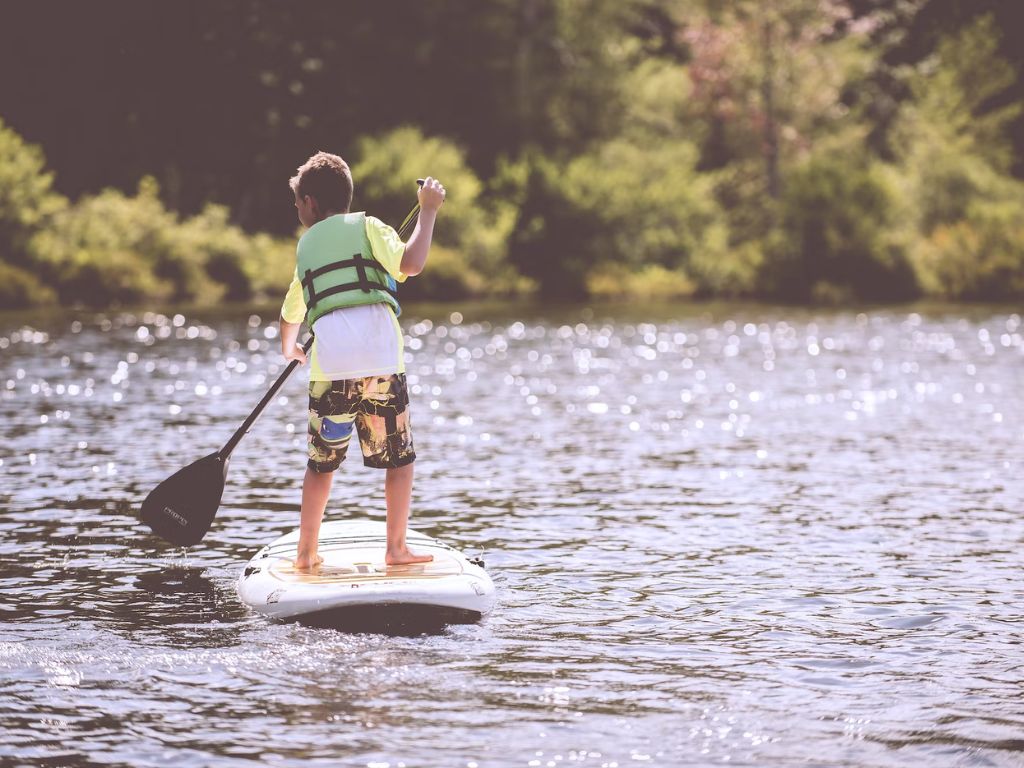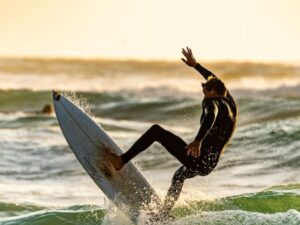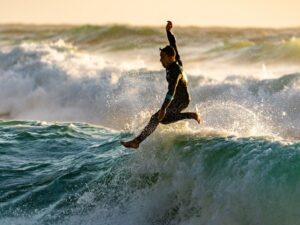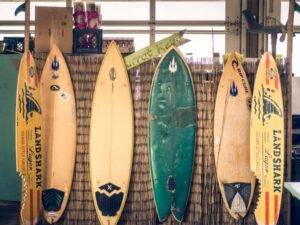It’s not exactly news that surfing and paddleboarding are quite different. You can only surf with a wave, while paddleboarding is a flat-water activity.
Sure, the basic design of a paddleboard is similar to that of a surfboard, with the critical difference being the presence of a paddle. This paddle is used to help the rider stay balanced and move through the water. But they can’t be interchangeable, can they?
You can use a paddleboard for surfing. A SUP, short for stand-up paddleboard (SUP), is a large, flat board propelled by a paddle. While paddleboards are typically designed for balance, they can also be used for surfing when equipped with the right accessories.
However, the endeavor would require a lot of skills from the rider. It’s also important to understand that paddleboards and surfboards are different. While they may look similar, they have other characteristics and are designed for different activities.
Paddleboards are generally wider, longer, and thicker than surfboards, offering a more stable platform for surfers. However, they are also slower and less maneuverable than surfboards, and they can be more challenging to ride in smaller surf.
Let’s look at the pros and cons of this charade.
Should you use a paddleboard for surfing?
Now that we’ve established, you can, in theory, surf with a paddleboard. Let’s get to the important question: should you?
| Pros | Cons |
| Increased stability | Increased weight |
| More speed | Expensive |
| A good workout for traditional surfers | It’s physically exhausting |
| Larger surface area catches more waves | Larger surface area makes it harder to control |
1. Pros of Surfing on paddleboards
1. Stability: paddleboards are much more stable than traditional surfboards, making them easier to balance. This makes them a good choice for surfing beginners.
2. Speed: These boards are more comprehensive and longer than traditional surfboards, which makes them faster. Additionally, the bigger surface area allows surfers to catch more waves and get more rides in a single session.
3. Good workout: Using a paddleboard for surfing requires a lot of physical exertion, which can help build strength and endurance and improve overall fitness.
2. Cons of Surfing on paddleboards
1. Size and weight: paddleboards are larger and heavier than surfboards, making them difficult to maneuver in the water. This can be incredibly challenging for smaller surfers when pitted against giant waves.
2. Cost: paddleboards are more expensive than traditional surfboards.
3. Maneuverability: These are more comprehensive and longer than traditional surfboards, hence less maneuverable in the water. It makes certain tricks and stunts on a paddleboard more challenging.
4. Physical exertion: They cause a lot of physical exertion, which can be exhausting for some surfers, especially those not in good physical shape.
How to use a paddleboard for surfing?
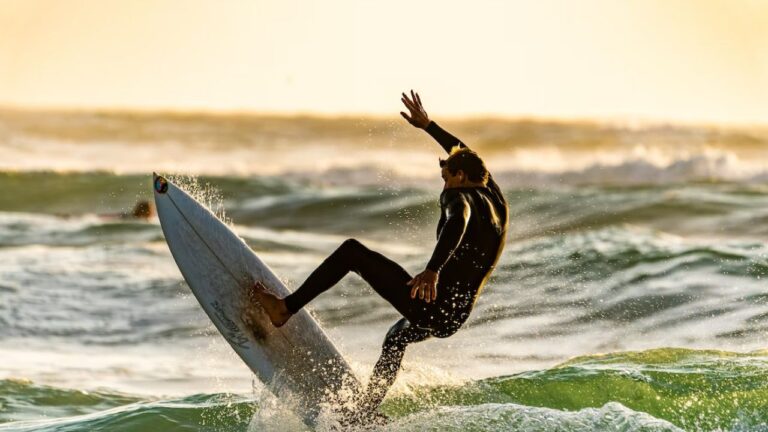
If you’re interested in using a paddleboard for surfing, listen to my instructions and do so carefully.
Step 1: Get the right gear.
You have the correct size paddleboard for your body type and skill level. Also, ensure you have the right accessories, such as a paddle and a leash, to make your surfing experience as safe and enjoyable as possible.
Step 2: Learn the proper techniques.
Learn how to paddle, catch a wave, and maneuver the board in the water.
Step 3: Paddle safely into the waves without breaking position.
The is to paddle into the waves with enough speed to catch them. You should start paddling in as soon as you see it coming.
Step 4: Get into the position.
After catching the wave, you must get into the proper position to ride it. Position your feet near the center of the board and crouch down to lower your center of gravity.
Step 5: It’s time to start surfing!
Start surfing the wa. In that case,e by shifting your weight back and forth and using your arms to balance. The goal is to stay safe on the wave as long as possible.
Step 6: Remember to practice!
Surfing on a paddleboard is a skill that takes time and dedication to master. So, practice, practice, and some more practice.
What size of paddleboard is good for surfing?
Here’s everything you need to consider when choosing a paddleboard for yourself:
- Skill level: For beginners, a larger paddleboard can provide more stability and help catch waves more easily. While a smaller paddleboard, ideal for experienced surfers, allows you to perform more advanced maneuvers and catch smaller waves.
- Body weight and height: Heavier and taller individuals may require a larger, longer paddleboard for added stability. Shorter individuals may prefer a smaller board for more maneuverability.
- Wave conditions: A small paddleboard is appropriate for smaller and easier waves and vice versa.
Here are some recommendations on paddleboard sizes per your skill level.
| Skill Level | Length | Width |
| Beginner | 10-12ft | 30-32 inches |
| Intermediate | 9-10ft | 28-30 inches |
| Advanced | 8-9ft | 26-28 inches |
Can you use inflatable paddleboards for surfing?
You can use inflatable paddleboards (iSUPs) for surfing. They’re more versatile and offer many of the same benefits as traditional paddleboards, including stability, buoyancy, and ease of transport. That said, they’re more difficult to maneuver.
This is because they are less rigid and responsive than solid ones. Some inflatable paddleboards may also be too small or lightweight to handle larger surf. So, you must choose one appropriate for your size, skill, and surfing type.

1. Pros of using inflatable paddleboards for surfing.
1. Portability: Inflatable paddleboards are much easier to transport than traditional surfboards. They can be deflated, rolled up, and placed in a backpack.
2. Durability: Unlike traditional surfboards, iSUPs are made of much more durable, high-quality materials. They are less likely to be damaged during transport or use and can withstand harsh conditions.
3. Price: Inflatable paddleboards are typically less expensive than traditional surfboards. This makes them a more affordable option for those looking to get into surfing but may want to invest less money in the sport.
4. Stability: iSUPs have a wide and stable design, which makes them ideal for surfing, especially for beginners. The board’s extra stability can help balance and make it easier to catch waves.
2. Cons of using inflatable paddleboards for surfing.
1. Performance: Inflatable paddleboards are slower and more responsive than traditional surfboards. This can make performing advanced tricks and maneuvers in the water more difficult.
2. Size: Inflatable paddleboards are typically larger and bulkier than traditional surfboards, making them less maneuverable. This can be especially challenging in crowded surf conditions where quick and precise movements are essential.
3. Weight: Inflatable paddleboards can be heavy and difficult to carry when inflated. This can make it difficult to transport them to and from the beach, especially for those traveling solo.
3. How to choose the right inflatable paddleboard for surfing?
Size: Choose a board that is the right size for your weight and skill level. A board that is too small can be unstable and difficult to control, while a board that is too large can be sluggish and slow.
Weight capacity: Make sure to choose a board that can support your weight and any additional gear or equipment you may need.
Inflation: Consider the inflation time and process and the maximum recommended pressure for the board. You’ll want to choose a board that can be inflated quickly and easily and withstand the pressure required for surfing.
Materials: Look for a board made of high-quality, durable materials designed to withstand the rigors of surfing.
Considering these factors, you can choose the right inflatable paddleboard for your surfing needs and enjoy the many benefits this versatile piece of equipment can offer.
Whether a seasoned surfer or a beginner, an inflatable paddleboard can help you catch more waves, improve your skills, and have more fun on the water.

